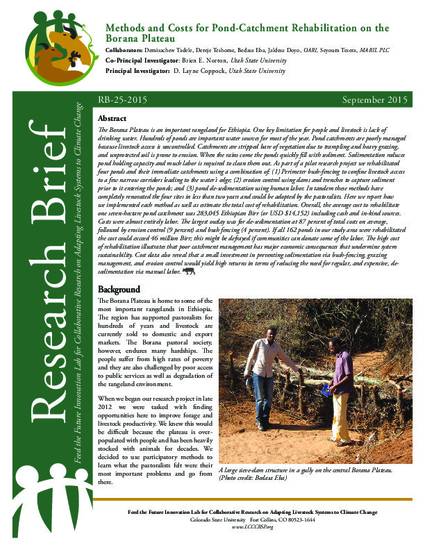
Book
Methods and Costs for Pond-Catchment Rehabilitation on the Borana Plateau
(2015)
Abstract
The Borana Plateau is an important rangeland for Ethiopia. One key limitation for people and livestock is lack of drinking water. Hundreds of ponds are important water sources for most of the year. Pond catchments are poorly managed because livestock access is uncontrolled. Catchments are stripped bare of vegetation due to trampling and heavy grazing, and unprotected soil is prone to erosion. When the rains come the ponds quickly fill with sediment. Sedimentation reduces pond holding capacity and much labor is required to clean them out. As part of a pilot research project we rehabilitated four ponds and their immediate catchment using a combination of: (1) Perimeter bush-fencing to confine livestock access to a few narrow corridors leading to the water's edge; (2) erosion control using dams and trenches to capture sediment prior to it entering the ponds; and (3) pond de-sedimentation using human labor. In tandem these methods have completely renovated the four sites in less than two years and could be adopted by the pastoralists. Here we report how we implemented each method as well as estimate the total cost of rehabilitation. Overall, the average cost to rehabilitate one seven-hectare pond catchment was 283, 045 Ethiopian Birr (or USD $14,152) including cash and in-kind sources. Costs were almost entirely labor. The largest outlay was for de-sedimentation at 87 percent of total costs on average, followed by erosion control (9 percent) and bush fencing (4 percent). If all 162 ponds in our study area were rehabilitated the cost would exceed 46 million Birr; this might be defrayed if communities can donate some of the labor. The high cost of rehabilitation illustrates that poor catchment management has major economic consequences that undermine system sustainability. Cost data also reveal that a small investment in preventing sedimentation via bush-fencing, grazing management, and erosion control would yield high returns in terms of reducing the need for regular, and expensive de-sedimentation via manual labor.
Disciplines
Publication Date
2015
Publisher
Colorado State University, Feed the Future Innovation Lab for Collaborative Research on Adapting Livestock Systems to Climate Change
Series
Research Brief RB-25-2015
Citation Information
Coppock, D.L., B.E. Norton, D. Tadele, D. Teshome, B. Eba, J. Doyo, and S. Tezera. 2015. Methods and Costs for Pond-Catchment Rehabilitation on the Borana Plateau. Research Brief-25-2015, Feed the Future—Adapting Livestock Systems to Climate Change, Colorado State University, Fort Collins, CO, USA. 5 pp.
